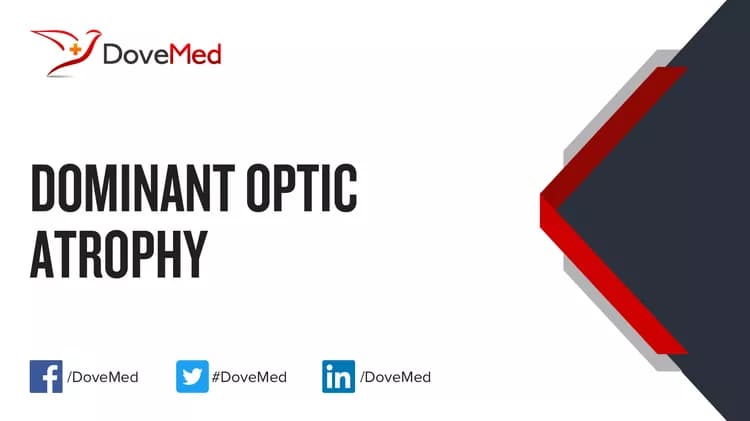What are the other Names for this Condition? (also known as/Synonyms)
- ADOA (Autosomal Dominant Optic Atrophy)
- Autosomal Dominant Optic Atrophy (ADOA)
- DOA (Dominant Optic Atrophy)
What is Dominant Optic Atrophy? (Definition/Background Information)
- Dominant Optic Atrophy (DOA) is an inherited optic nerve disorder characterized by degeneration of the optic nerves. It typically starts during the first decade of life
- Affected people usually develop moderate visual loss and color vision defects. The severity varies and visual acuity can range from normal to legal blindness
- About 20% of people with DOA have non-ocular features, such as sensorineural hearing loss; myopathy; peripheral neuropathy; multiple sclerosis-like illness; and spastic paraplegia (impaired function of the legs). These cases may be referred to as 'DOA plus’
- Dominant Optic Atrophy is inherited in an autosomal dominant manner and may be caused by a mutation in any of several genes, some of which have not been identified
- There is currently no way to prevent or cure Dominant Optic Atrophy, but affected people may benefit from low vision aids
(Source: Dominant Optic Atrophy; Genetic and Rare Disease Information Center (GARD) of National Center for Advancing Translational Science (NCATS), USA.)
Who gets Dominant Optic Atrophy? (Age and Sex Distribution)
- Dominant Optic Atrophy is a rare congenital disorder. The presentation of symptoms may occur before the age of 10
- Both males and females may be affected
- Worldwide, individuals of all racial and ethnic groups may be affected
What are the Risk Factors for Dominant Optic Atrophy? (Predisposing Factors)
- A positive family history may be an important risk factor, since Dominant Optic Atrophy can be inherited
- Currently, no other risk factors have been clearly identified for DOA
It is important to note that having a risk factor does not mean that one will get the condition. A risk factor increases one’s chances of getting a condition compared to an individual without the risk factors. Some risk factors are more important than others.
Also, not having a risk factor does not mean that an individual will not get the condition. It is always important to discuss the effect of risk factors with your healthcare provider.
What are the Causes of Dominant Optic Atrophy? (Etiology)
- Most cases of Dominant Optic Atrophy are caused by mutation(s) in the OPA1 gene
- In addition, mutation(s) in some other genes, as yet unidentified, may also cause DOA
- The condition is inherited in an autosomal dominant manner, with reduced penetrance and variable expression
Autosomal dominant inheritance: Autosomal dominant conditions are traits or disorders that are present when only one copy of the mutation is inherited on a non-sex chromosome. In these types of conditions, the individual has one normal copy and one mutant copy of the gene. The abnormal gene dominates, masking the effects of the correctly function gene. If an individual has an autosomal dominant condition, the chance of passing the abnormal gene on to their offspring is 50%. Children, who do not inherit the abnormal gene, will not develop the condition or pass it on to their offspring.
Autosomal dominant inheritance with reduced or incomplete penetrance: Not everyone who inherits the faulty gene develops the condition, indicating other genetic and environmental factors may play a role in the development of disease.
Autosomal dominant inheritance with variable expressivity: The type and severity of signs and symptoms may vary among affected individuals, even within the same family.
What are the Signs and Symptoms of Dominant Optic Atrophy?
The signs and symptoms of Dominant Optic Atrophy may vary in type and severity among affected individuals, and may include:
- Vision impairment
- Impaired color vision
In addition, the following signs and symptoms may be present in some affected individuals, who are categorized as “DOA plus”
- Sensorineural hearing loss
- Myopathy
- Peripheral neuropathy
- Multiple sclerosis-like illness
- Spastic paraplegia (impaired function of the legs)
(Source: Dominant Optic Atrophy; Genetic and Rare Disease Information Center (GARD) of National Center for Advancing Translational Science (NCATS), USA.)
How is Dominant Optic Atrophy Diagnosed?
Dominant Optic Atrophy is diagnosed on the basis of the following information:
- Complete physical examination
- Thorough medical history evaluation
- Assessment of signs and symptoms
- Laboratory tests
- Imaging studies
- Biopsy studies, if necessary
Many clinical conditions may have similar signs and symptoms. Your healthcare provider may perform additional tests to rule out other clinical conditions to arrive at a definitive diagnosis.
What are the possible Complications of Dominant Optic Atrophy?
The complications of Dominant Optic Atrophy may include:
- Progression to severe loss of vision acuity, such as to become legally blind
- Progressive hearing loss
- Anxiety
- Depression
- Problems with movement, due to muscle weakness and paraplegia
Complications may occur with or without treatment, and in some cases, due to treatment also.
How is Dominant Optic Atrophy Treated?
There is currently no cure for Dominant Optic Atrophy.
- Management generally consists of regular eye exams, including measurement of visual acuity, color vision, visual fields and optical coherence tomography (OCT)
- Currently there is no specific treatment, but low-vision aids in individuals with severely decreased visual acuity can be helpful
- Cochlear implants have been shown to markedly improve hearing in individuals with sensorineural hearing loss
(Source: Dominant Optic Atrophy; Genetic and Rare Disease Information Center (GARD) of National Center for Advancing Translational Science (NCATS), USA.)
How can Dominant Optic Atrophy be Prevented?
Dominant Optic Atrophy may not be preventable, since it is a genetic disorder.
- Genetic testing of the expecting parents (and related family members) and prenatal diagnosis (molecular testing of the fetus during pregnancy), if available, may help in understanding the risks better during pregnancy
- If there is a family history of the condition, then genetic counseling will help assess risks, before planning for a child
- Cessation of smoking and avoiding alcohol consumption may help slow the progression of the disease
- Similarly, avoiding certain medications (such as antibiotics and antiviral medications) that interfere with mitochondrial metabolism, may also slow progression of the condition
- Active research is currently being performed to explore the possibilities for treatment and prevention of genetic disorders such as Dominant Optic Atrophy
- Regular medical screening at periodic intervals with tests and physical examinations are recommended
What is the Prognosis of Dominant Optic Atrophy? (Outcomes/Resolutions)
- The prognosis of Dominant Optic Atrophy is dependent upon the severity of the signs and symptoms and associated complications, if any
- Individuals with mild conditions have better prognosis than those with severe symptoms and complications
- Typically, the prognosis may be assessed on a case-by-case basis
Additional and Relevant Useful Information for Dominant Optic Atrophy:
The following DoveMed website link is a useful resource for additional information:
Related Articles
Test Your Knowledge
Asked by users
Related Centers
Related Specialties
Related Physicians
Related Procedures
Related Resources
Join DoveHubs
and connect with fellow professionals



0 Comments
Please log in to post a comment.